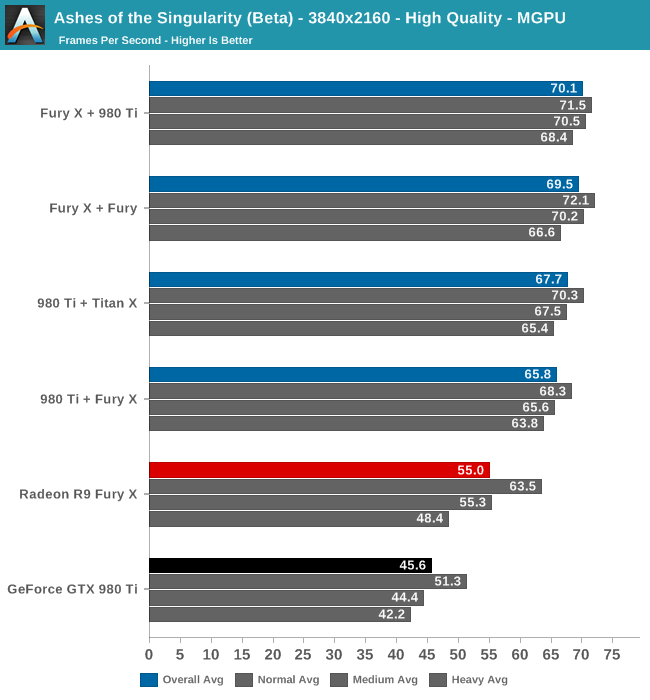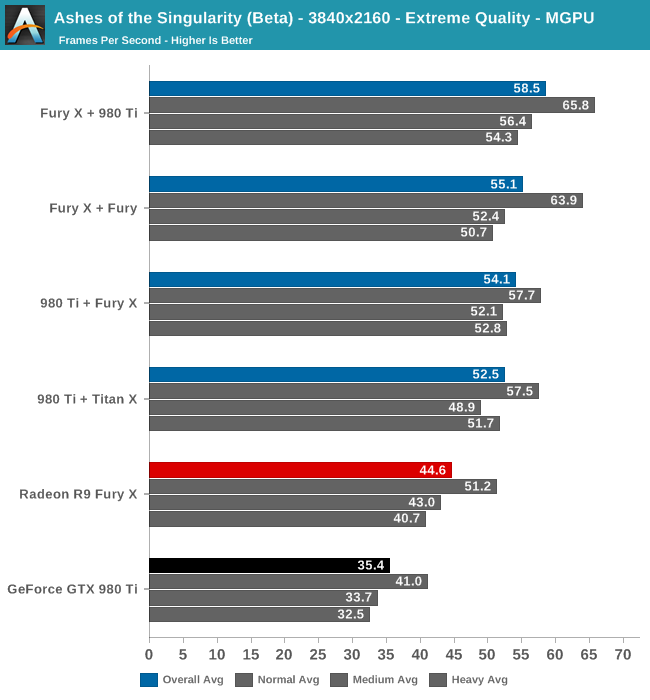Ashes of the Singularity Revisited: A Beta Look at DirectX 12 & Asynchronous Shading
by Daniel Williams & Ryan Smith on February 24, 2016 1:00 PM ESTDirectX 12 Multi-GPU Performance
Shifting gears, let’s take a look at multi-GPU performance on the latest Ashes beta. The focus of our previous article, Ashes’ support for DX12 explicit multi-GPU makes it the first game to support the ability to pair up RTG and NVIDIA GPUs in an AFR setup. Like traditional same-vendor AFR configurations, Ashes’ AFR setup works best when both GPUs are similar in performance, so although this technology does allow for some unusual cross-vendor comparisons, it does not (yet) benefit from pairing up GPUs that widely differ in performance, such as a last-generation video card with a current-generation video card. None the less, running a Radeon and a GeForce card together is an interesting sight, if only for the sheer audacity of it.
Meanwhile as a result of the significant performance optimizations between the last beta build and this latest build, this has also had an equally significant knock-on effect on mutli-GPU performance as compared to the last time we looked at the game.

Even at 4K a pair of GPUs ends up being almost too much at Ashes’ High quality setting. All four multi-GPU configurations are over 60fps, with the fastest Fury X + 980 Ti configuration nudging past 70fps. Meanwhile the lead over our two fastest single-GPU configurations is not especially great, particularly compared to the Fury X, with the Fury X + 980 Ti configuration only coming in 15fps (27%) faster than a single GPU. The all-NVIDIA comparison does fare better in this regard, but only because of GTX 980 Ti’s lower initial performance.
Digging deeper, what we find is that even at 4K we’re actually CPU limited according to the benchmark data. Across all four multi-GPU configurations, our hex-core overclocked Core i7-4960X can only setup frames at roughly 70fps, versus 100fps+ for a single-GPU configuration.

Top: Fury X. Bottom: Fury X + 980 Ti
The increased CPU load from utilizing multi-GPU is to be expected, as the CPU now needs to spend time synchronizing the GPUs and waiting on them to transfer data between each other. However dropping to 70fps means that Ashes has become a surprisingly heavy CPU test as well, and that 4K at high quality alone isn’t enough to max out our dual GPU configurations.

Cranking up the quality setting to Extreme finally gives our dual-GPU configurations enough of a workload to back off from the CPU performance cap. Once again the fastest configuration is the Fury X + 980 Ti, which lands just short of 60fps, followed by the Fury X + Fury configuration at 55.1fps. In our first look at Ashes multi-GPU scaling we found that having a Fury X card as the lead card resulted in better performance, and this has not changed for the newest beta. The Fury continues to be faster at reading data off of other cards. Still, the gap between the Fury X + 980 Ti configuration and the 980 Ti + Fury X configuration has closed some as compared to last time, and now stands at 11%.
Backing off from the CPU limit has also put the multi-GPU configurations well ahead of the single-GPU configurations. We’re now looking at upwards of a 65% performance boost versus a single GTX 980, and a smaller 31% performance boost versus a single Fury X. These are smaller gains for multi-GPU configurations than we first saw last year, but it’s also very much a consequence of Ashes’ improved performance across the board. Though we didn’t have time to test it, Ashes does have one higher quality setting – Crazy – which may drive a bit of a larger wedge between the multi-GPU configurations and the Fury X, though the overhead of synchronization will always present a roadblock.












153 Comments
View All Comments
dustwalker13 - Thursday, February 25, 2016 - link
or ... not to put to fine a point on it, nvidias program and strategy to optimize games for their cards (aka in some instances actively sabotaging the competitions performance through using specialized operations that run great on nvidias hardware but very poorly on others) has lead to a near perfect usage of DX11 for them while amd was struggling along.on ashes, where there is no such interference, amd seems to be able to utilize the strong points of its architecture (it seems to be better suited for DX12) while nvidia has had no chance to "optimize" the competition out of the top spot ... too bad spaceships do not have hair ... ;P
prtskg - Thursday, February 25, 2016 - link
Lol! spaceships don't have hair. I'd have upvoted your comment if there was such an option.HalloweenJack - Thursday, February 25, 2016 - link
Waiting for Nvidia to `fix` async - just as they promised DX12 drivers for Fermi 4 months ago.....Harry Lloyd - Thursday, February 25, 2016 - link
Well, AMD has had bad DX11 performance for years, they clearly focused their architecture on Mantle/DX12, because they knew they would be producing GPUs for consoles. That will finally pay off this year.NVIDIA focused on DX11, having a big advantage for four years, and now they have to catch up, if not with Pascal, then with Volta next year.
doggface - Thursday, February 25, 2016 - link
Personally as the owner of an nVidia card, I have to say Bravo AMD. That's some impressive gains and I look forward to the coming D12 GPU wars from which we will all benefit.minijedimaster - Thursday, February 25, 2016 - link
Exactly. Also as a current Nvidia card owner, I don't feel the need to rush to a Windows 10 upgrade. Seems I have several months or more before I'll be looking into it. In the mean time DX11 will do just fine for me.mayankleoboy1 - Thursday, February 25, 2016 - link
AMD released 16.2 Crimson Edition drivers with more performance for AotS.Will you be re-benchmarking the game?
Link: http://support.amd.com/en-us/kb-articles/Pages/AMD...
albert89 - Thursday, February 25, 2016 - link
The reason why Nvidia is losing ground to AMD is because their GPU's are predominantly serial or DX11 while AMD as it is turning out is parallel (DX12) and has been for a number of years. And not only that, but are on their 3rd Gen of parallel architecture.watzupken - Thursday, February 25, 2016 - link
Not sure if its possible to retest this with a Tonga card with 4GB Vram, i.e. R9 380x or 380? Just a little curious why it seems to be lagging behind quite a fair bit.Anyway, its good to see the investment in DX 12 paying off for AMD. At least owners of older AMD cards can get a performance boost when DX 12 become more popular this year and the next. Not too sure about Nvidia cards, but they seem to be very focused on optimizing for DX 11 with their current gen cards and certainly seems to be doing the right thing for themselves since they are still doing very well.
silverblue - Friday, February 26, 2016 - link
Tonga has more ACEs than Tahiti, so this could be one of those circumstances, given more memory, of Tonga actually beating out the 7970/280X. However, according to AT's own article on the subject - http://www.anandtech.com/show/9124/amd-dives-deep-... - AMD admits the extra ACEs are likely overkill, though to be fair, I think with DX12 and VR, we're about to find out.